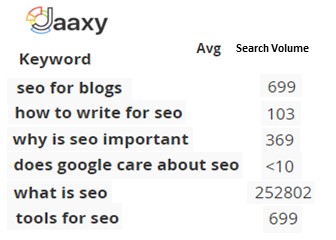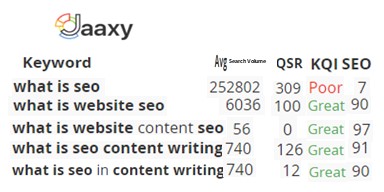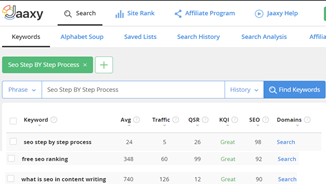What Is SEO In Content Writing To Get Free SEO Ranking
Are you wondering What Is SEO In Content Writing To Get Free SEO Ranking? We explain and show examples. We show you ten steps that work.
First, let’s clarify some terminology so the ten SEO steps we use will have more meaning.
SEO Terms Definitions For What Is SEO In Content Writing To Get Free SEO Ranking
SEO terms may be confusing; however definitions always help. Here are the important ones to help you follow the Ten Step Process below.
What Is SEO?
SEO is the abbreviation for Search Engine Optimization. Search Engines such as Google, Bing and Yahoo crawl website pages, blogs, You Tube and social media to index the content so it can be presented to web surfers. Web surfers expect to be presented with relevant information. Search Engines have a difficult time indexing information if it is not organized and focused. Content writing that is optimized (focused and organized by a keyword or phrase) makes crawling so much more accurate to the point that such content is given preferential placement.
Gurus who write the algorithms for content indexing know the major search engines jockey for the most users. Being known as the number one place to go for information boosts their bottom line. So it behooves content writers to learn the SEO Steps Process.
What Is SEO In Content Writing?
SEO in content writing is the selection, organization and focus of words and phrases optimized so Search Engines can index the content properly. Search engines look for the selection of words or phases of focus in the content. Then they look at the organization of the content which is portrayed through paragraph headings. If the key words and phrases are not evident and a case is not built for their usage within the content, the search engines will have great difficulty indexing.
What Is Free SEO Ranking?
Free SEO ranking is the result of search engine indexing. The indexes contain many pages with similar content. The pages are time stamped. The page that is indexed first and most closely relates to the search is displayed in the search results as number one for web searchers.
Over time the search engines collect data regarding how long visitors spend on a page. Those pages with the longest viewing time will be deemed as the most useful and therefore outrank pages that have an older indexed date. Every time content writing is presented in the search results and a surfer chooses to visit your page, you are getting free traffic to your website.
What Is SEO In Content Writing Goal?
The goal of every writer is to get more visitors to their site. To do this SEO rules must be followed. We keep working with SEO to refine the process. The following Ten SEO Steps are what we use to get traffic from free SEO ranking.
As you read the 10 SEO Steps Process, keep in mind the definitions. See if you can relate to the information and examples. We want your page content to rank well in the search engines so you too can get free traffic as the result of your good SEO.
The SEO Step By Step Process In Content Writing For Free SEO Ranking
Here are the 10 Steps we use for writing our content. We perform the steps in the order listed.
- Gather Words Or Phrases About A Topic Of Interest
- Learn What Interests Web Searchers
- Identify The Number Of Competing Websites Already Existing For The Key Phrases Of Interest
- Select A Title For The Website Page
- Create A Road Map For The Content That Supports The Title
- Create Subheadings Based On The Road Map
- Write The Content For The Introduction, Road Map Steps And The Conclusion
- Review The Content To See If It Stays On Topic
- Use The WordPress Plugin Yoast To Measure The Usage Of SEO In Content
- Fix The SEO Problems Identified By Yoast
Learn what each step is. We provide examples of each to increase understanding.
STEP 1 Gather Words Or Phrases About A Topic Of Interest
Step 1 Starts when a writer begins to think about a topic of interest. The initial ideas are usually a combination of very broad and very narrow topics. Capturing all ideas that come to mind are useful at this point.
Let’s look at an example. While doing a broad scope about content writing for this page, I am thinking of doing something on SEO. The following thoughts come to my mind.
SEO for blogs and pages; How to write for SEO, Why Is SEO important; Does Google, Bing or Yahoo care about SEO, What Is SEO. Tools for SEO and on and on.
All of these ideas are good and have potential.
GOOD SEO means the writer selects a word or phrase for the content to be written. Writing content without a focus results in confusion and frustration. I am sure you have stumbled upon a long blog or page on the internet that uses images which convey a message but the words leave you bewildered because you have no idea what the writer is trying to say. Obviously if you can’t follow the content, the search engine can’t because it has no eyes.
Step 2 Learn What Interests Web Searchers
Step 2 Involves learning what interests those who search the internet.
 My interest about the topic may not be meaningful to my audience. It is important for me to learn what web searchers are looking for; what problems they face; what misunderstanding they have regarding the topic. By learning what the surfers are looking for I can maximize my opportunity.
My interest about the topic may not be meaningful to my audience. It is important for me to learn what web searchers are looking for; what problems they face; what misunderstanding they have regarding the topic. By learning what the surfers are looking for I can maximize my opportunity.
Here is what I find when using Jaaxy, my favorite Keyword Research Tool. Interest is very high for “What is SEO”. It is lowest for “Does Google Care About SEO”.
GOOD SEO WRITERS will select a topic that has high interest. Why spend several hours writing content about something that has little interest? The key phrase that appeals to me most is “What Is SEO”.
Step 3 Identify The Number Of Competing Websites Already Existing For The Key Phrases Of Interest
 Step 3 involves learning how many other content pages and blogs already discuss my topic. Regardless of the number of existing pages on my topic, SEO will index my page; however, the questions is “will it appear in the search results on page one?” If not, then I need to determine if it is possible to outrank the existing pages by writing more thorough and outstanding content so my content will appear before theirs.
Step 3 involves learning how many other content pages and blogs already discuss my topic. Regardless of the number of existing pages on my topic, SEO will index my page; however, the questions is “will it appear in the search results on page one?” If not, then I need to determine if it is possible to outrank the existing pages by writing more thorough and outstanding content so my content will appear before theirs.
Common Sense tells me that I need to narrow my scope. Jaaxy tells me there are already 309 blogs discussing “What is SEO” and because of the high number of competing website my SEO ranking score will be Poor. So my next step is to narrow the topic “What is SEO”.
My new ideas include the following.
What is website SEO; What is website content SEO; What is SEO content writing and What is SEO in content writing.
Based on Jaaxy results, I am selecting the phrase “What is SEO in content writing”. The volume of searches is 740 per month. There are only 12 other websites with the same phrase and the SEO score is 90 which is great.
Step 4 Select A Title For The Website Page
Step 4 requires I make a decision regarding the page title and the usage of an additional H2 subtitle heading. (The theme I am using does not allow me to create a unique H1 tag; therefore I am using a H2 tag.) Jaaxy provides the help I need to make my decision.
 The phrase “What is SEO in Content Writing is a very good phrase” and has a great volume of traffic potential; therefore I am going to make this my page title.
The phrase “What is SEO in Content Writing is a very good phrase” and has a great volume of traffic potential; therefore I am going to make this my page title.
As I think about this more, I am thinking the following.
I am writing about what SEO is in content, but for what purpose am I writing the page? Of course my goal is to help my readers understand what SEO is in a page but I believe I am trying to accomplish more!
Jaaxy tells me the search for “Free SEO Ranking” is over 300. My conclusion is that the phase “To Get Free SEO Ranking” will be added to the original page title and used as the initial subheading when readers enter the page. I think “What is SEO in Content Writing To Get Free SEO Ranking” is a great subheading I can use “SEO Step By Step Process” as a subheading for the Ten SEO Steps Process addressed later in my content.
So my decision for this step means that the content URL and the Content Title will use the same wording.
Step 5 Create A Road Map For The Content That Supports The Title
Step 5 requires I think through the flow for the content and identify which is the most logical way to show the role of SEO in the content.
In my case, my content is all about two things 1) SEO terms definitions and 2) the role of SEO in the content. So I decide my best road map is using two major headings: 1) SEO Terms Definitions and 2) The SEO Step By Step process. My road map will be further defined by subheadings under the two major headings. This will make my content SEO rich.
Here is my road map.
I. SEO Terms Definitions
II. The Ten SEO Step Process
Step 6 Create Subheadings Based On The Road Map
Step 6 requires careful selection of sub headings to capture the intent of the content, to follow the thought flow and to create reader interest.
Since the content is a step by step process, it seems most appropriate to identify each subheading with a step. The step number progression accentuates the flow. The titles for each step keep the reader engaged.
Step 7 Write The Content For The Introduction, Road Map Steps And The Conclusion
Step 7 requires writing an introduction that is captivating and sets reader expectation. The body of the content must stay focused and provide definitions, explanations and examples so the reader finds value. The conclusion should summarize the content along with a writer challenge or recommendation.
To achieve this step, I have an introduction which asks the readers a question to hopefully engage them. This is followed by an expectation how the answer to the question will be handled.
The body of the content defines SEO and identifies the Process steps. Each step contains a paragraph explaining what the step is about and an example of how to perform it.
The conclusion summarizes the content and encourages the user to implement the process in his/her content writing.
Step 8 Review The Content To See If It Stays On Topic
Step 8 requires me to review what I have written.
During my review, I find my original introduction did not tell the reader what to expect. So I added “Using Ten Steps” to prepare the reader for my road map. I also added “With Explanation And Example” so the reader can relax because examples will be provided.
As for the body, I find I am consistent in presenting the heading for each step, my thought process in achieving it, an example to demonstrate that I did the step.
My conclusion is a summary of the content and makes one last pitch that SEO is a step by step process and that each step must be performed to achieve high SEO ratings with the search engines.
Let me know what you think. Does SEO in content writing make more sense now?
Step 9 Use The WordPress Plugin Yoast To Measure The Usage Of SEO In Content
Step 9 requires the free plugin Yoast to be installed and activated. Upon activation it begins to evaluate the content writing for SEO effectiveness.
Step 10 Fix The SEO Problems Identified By Yoast
Based on the above written content, Yoast thinks I have done a good job! Here is what the plugin evaluation tells me.
✓ The exact match of the key phrase appears at the beginning of the SEO title.✓ More than half of my key phase appears in the page URL.✓ The SEO title is good.✓ The meta description contains the key phrase.✓ Yoast is very happy that the key phrase is found 14 times.✓ My introduction uses the key phrase.✓ The length of the key phrase is good.
Based on feedback from Yoast, I have nothing to fix. Wonderful. This means I am ready to publish my page.
Conclusion
SEO in content writing is a step by step process. Performing each step in order will ensure your page gets ranked well. Following a process consistently makes writing easier.
Readers want answers to questions and solutions for problems. Explanation and illustration are a great way to ensure clarity is achieved.
What Next?
Try the ten step SEO process and let us know what you think. How do you make sure your content writing is SEO rich?
The tool mentioned above, Jaaxy, is available for 30 free searches. Here’s the sign-up.

I really did not know how much SEO really plays a huge role in the ranking of my website pages and posts. I really want to thank you for opening up my eyes to this. I will try to use your SEO recommendations on all of my future posts.
I have wondered how I could get better SEO rankings. It will take a lot of patience to follow your instructions step by step. But what you have said makes a lot of sense to me.
I have tried Jaaxy. It makes keyword research so easy and fast and more more reliable. I am amazed at how accurate Jaaxy is. I checked it with Google results and it was right on. It is hard for me to imagine why more people do not sign up to use Jaaxy because it provides the number of seraches per month, how many searches my website could expect if it shows up on page 1 of a Google search; how many other websites are using my keyword phrase. The green wording makes the results stand out. I always try to look for green because too much competition is too hard to rank.
What do you recommend for the number of searches my site would be verses the number of competing websites? What do you recommend as a ratio?
My website is in a very competitive niche so I am being challenged to get much traffic. What would you recommend I do?
Also how much has your traffic increased by percentage since you have followed the SEO steps you outline above?
Thank you for your insight